Time to design plans

The waste problem is twofold. On the one hand, because, as has already been indicated, there are more and more waste and, on the other, because the legalization period of landfills established in the Directive of the European Union in this regard is getting closer and closer.
Plans should choose between landfill substitutes and the debate around this issue does not seem an easy task. Recycling, composing and incinerating are the options that are most mentioned, but there is also a voice that says “what if we generate less waste?”
Some organizations have things clear and the decisions to make have already been made, but many others still have more doubts to decide. Therefore, everyone goes at their own pace, although the problem and the deadlines are the same for everyone.
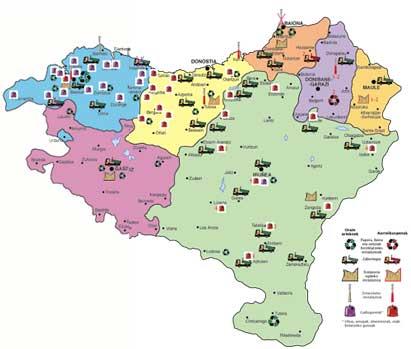
More and more garbage
Focusing on waste production, in recent years we have to highlight a couple of changes. On the one hand, the growing generation of waste and on the other, the composition of waste.
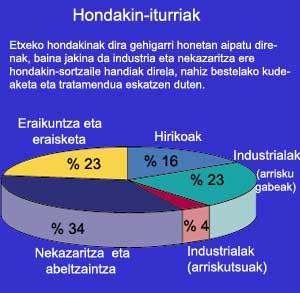
In quantitative terms, institutions, social agents and citizens highlight the need to produce less. However, despite this joint opinion, in almost all countries more and more waste is generated, and seeing the trend of consumption, one could hardly think that it will be reduced. At best, in Gipuzkoa, for example, the amount of waste is maintained from year to year, but in Álava and Navarra it has increased considerably.
The composition of household waste is also changing with consumption. The garbage bag is increasingly made up of different materials. Therefore, the recycling of increasing amounts of packaging is not only due to the increase in citizen awareness.
What to do with all these waste? This is the question that public institutions must answer. Some countries have already prepared their plans for the coming years, but not everything is decided and public institutions have their origin in the work.
Production by country 2000Increase by inhabitant(latest data)
Gipuzkoa
Bizkaia
Araba
Nafarroa
North
297.488
459.694
104.272
237.701
126.000297.468
452.799
111.108
233.894
130.000% -1.5%
6.5% -1.6% 2,41.17 kg/day
1.1 kg/day
1.06
kg/day
1.22 kg/day
Responsibility to Municipalities
The collection and treatment of household waste in Euskal Herria is in the hands of municipalities, but it is not the responsibility of the mayor. The Waste Management Plan is led by Provincial Councils and inter-local entities.
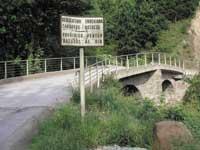
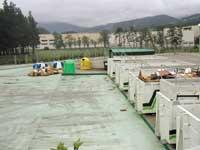
There are currently Integrated Urban Solid Waste Management Plans in the three provinces that make up the ACBC. The management plan of Bizkaia is approved by the Provincial Council, in Gipuzkoa the most suitable of the seven plans will be selected in the month of November and in Alava is still in development phase. These Integrated Plans are linked to the Master Plan for Urban Solid Waste Management of the Autonomous Community of the Basque Country (1998).
The plan presented by the Provincial Council of Bizkaia prioritizes recycling, but not being able to recycle all materials, emphasizes the need for a large incinerator in the area of Bilbao. The incinerating plant called Zabalgarbi will be built in Artigas and will have a treatment capacity of 228,000 tons of waste per year.
In Gipuzkoa there are seven plans on the table. As in Bizkaia, they emphasize that recycling and incineration are complementary, but they do not rule out composting plant or mechanical-biological. In the latter case, before its landfill deposit, the waste would be stabilized and its volume reduced. The most appropriate plan will be decided in November, but the most cited plan of the Provincial Council foresees the construction of two incinerating plants in Gipuzkoa, one in Tolosaldea and another in Txingudi. In addition, in 2016 the management of 541,996 tons of waste is expected.
Alava, for its part, is closer than other provinces and the Council has not yet presented any plan. However, it has made clear that incineration facilities will not be built in Alava.
In the North Basque Country management is in the hands of trade unions, that is, some interurban structures. The candidate of Beskoitz, Jean Falagan, said that “today all the peoples of Ipar Euskal Herria are grouped in 14 unions, but soon we will create the union Bil ta Garbi, which will bring together the majority of them”. (When the interview was conducted the date was not yet set.) The new union would ensure the treatment of all waste in the North Basque Country, while the collection would remain in the hands of the city councils as previously.
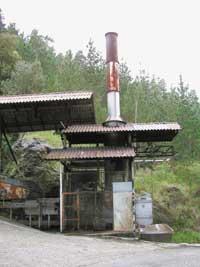
According to the municipalities in favor of the union Bil and Garbi, the treatment of waste in the North Basque Country will require two separation zones, two landfills, two composting constructions and one or two incineration plants. Disagreement is the location of all these buildings, which no one wants in their village. In addition, coastal towns were originally expected to reach 66% of the vote, so the representatives of the inland peoples feared that all buildings would be built indoors. It seems that this will not happen and the number of votes will be reviewed.
In addition to this planning that is being agreed between the municipalities of the North Basque Country, Mr. Gourgan, Environment Manager of the General Council, said that “countries on both sides of the border collaborate in joint waste management as far as possible.” At the time of writing the article it was not yet possible to publish the results of the work done, but the project is expected to be communicated before the summer.
In the case of Navarra, following the Master Plan for Urban Solid Waste of 1989, the adaptation of data and the new European directive, they designed a waste management plan in 1999. It must be reviewed within five years (next year). The plan was designed taking into account technological advances and other plans and with the necessary forecasts.
This Plan presents the current situation of waste management in Navarra by regions and sets the objectives for the coming years. Among other things, the Plan aims to be a reference for all actions that are carried out in waste and coordinates all of them. The main objectives are the minimization of waste generation, the impulse of selective collection and the minimization of waste destined to landfills and incineration facilities.
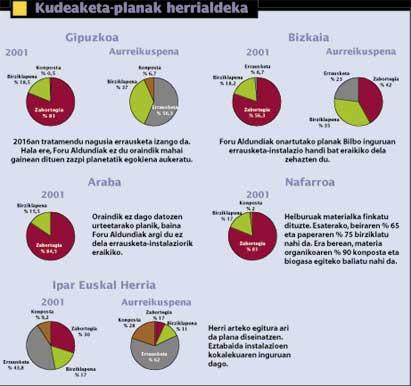
90% of waste cannot be incinerated
The new plans of Gipuzkoa and Bizkaia foresee incineration treatment. What do you think?
We are totally against incineration.
A few years ago a debate was held in Gipuzkoa. Public institutions, social agents and interested persons could participate in it. The result of this debate was the rejection of incineration. But all the plans presented by the Provincial Council of Gipuzkoa bet on incineration. What the council likes most is the construction of three small incineration facilities.
In Bizkaia it is foreseen the construction of an imposing incinerator. The debate focuses mainly on localization and the pernicious effects of incineration have been somewhat hidden.
Why are you against incineration?
On the one hand, because there are technical problems and on the other, those related to health.
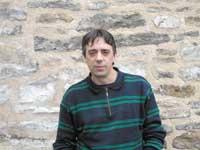
In terms of technical problems, first of all, deformation should be mentioned. On the one hand there is the building, but even the incineration plant must also carry the high voltage lines, so there are several elements that distort it.
In addition, the incinerating plant will have numerous trucks daily that will cause contamination, noise and obstruction of the roads.
Add the health effects to this. First of all, we must not forget that ash can account for 30% of initial waste, so in addition to incineration a landfill is needed. The amount of waste will be reduced, but all remaining ashes will be large pollutants. Therefore, we will move from household waste to very toxic waste, which is a new treatment.
In addition, furans and dioxins are among the gases causing incineration and those harmful to health. We must know that the furans were one of the components of the Napal orange gas used by the Americans during the Vietnam War. Let everyone draw their conclusions. Carbon monoxide, sulfur dioxide and inorganic compounds of chlorine and fluoride are also emitted. It has been proven that the filters used are very ineffective in incinerators in other areas.
What solution do you propose?
Incineration supporters claim that the fire of waste reduces the amount of waste, thus solving the problem of landfills. In addition, they add that the amount of waste that is not recycled is still important and consider that the solution to reduce this volume is to burn.
In this approach there are two errors: what I call ‘psychological’, which affects the individual and the technician.
What is that psychological error?
If institutions are campaigning for recycling and at the same time raising incineration, how are we going to make people see that garbage serves something? With this kind of approach, people think: “If it burns, why do I assume responsibility for depositing the classified waste? From a psychological point of view it seems to me a contradiction.
And what is the technical error?
They argue that there is no other solution than recycling or incineration. Recycling is not harmful, but not beneficial.
The first task is to minimize the use of materials in productions.
On the other hand, there are materials that can and should be enhanced. Before, for example, when making the purchase, each went with his basket and the glass bottles, once empty, returned to the store for reuse. Why not now?
If the first two steps are abandoned and recycling is used directly, it is known that landfills are going to be filled and with this other problems are going to be generated such as leachates, odor, diseases, etc.
On the other hand, the waste bags of those who do not selectively deposit the waste are destined directly to landfill or incinerating plant. Once the recovery force has been carried out on this road, the waste would be 20%. Of course, the recycling material is usually stained and therefore has worse quality, but cannot be disposed of.
Incineration is also a source of energy.
We do not believe that incineration is the best way to generate energy.
There are also non-recyclable waste.
In the case of hospital waste, for example, incineration may be essential, but these are isolated cases.
In the case of household waste, let us return to the initial questions, why is the use of non-recyclable materials allowed in production?
Burning waste is energy source
Would you present the Zabalgarbi project in two words?
Zabalgarbi is an incinerator that will treat 228,000 tons of waste. That is, Bizkaia's waste management plan plans to treat 23% of waste.
In addition, the combustion of waste is a source of energy, so, according to European regulations, energy will be generated in Zabalgarbi. Europe insists on the need to value waste, as far as possible in a material and non-energy way.
In Zabalgarbi we will. The annual power generation will be 710 million kW and will be sold at market prices.
The budget for this project amounts to 25 billion pesetas and the works will end by 2004. 57% of the company created for the construction of Zabalgarbi belongs to private companies and 43% to public entities.
Approximately 20-30% of these waste will become ash. What will be done with the ashes generated?
Transfer the ashes to a safety dump. Previously they will become inert, that is, they will stabilize to avoid the generation of leachates.
And what do you think of the dangers of dioxins so mentioned?
According to the Cancer Institute, only one in 210 dioxins increases the risk of cancer. Cancer risk is said to increase 1.4 times when a significant spill occurs (the risk of passive smokers increases 1.2 times and that of smokers 20 times).
For example, after the explosion in 1976 in Seveso (Italy), the amount of dioxins that expanded has never been known, but it has been written that in 20 minutes between 2 and 18 kilos were emitted. However, research has not shown that cancer cases increased as a result of the accident. Animals died, but this is because dioxins affect species more than others.
Zabalgarbi will only emit 1.4 grams of dioxin in 25 years.
Do you think incineration zones are essential?
Although waste generation should be minimized, it is true that there are more and more waste. It is very important that the waste is deposited separately to be able to recycle them to the maximum, but it must be clear that you cannot recycle everything (what is not separated, poor quality paper, some types of plastics…). In addition, good quality composting is very difficult with household waste.
Therefore, the Bizkaia plan aims to minimize dumping to the landfill and complement the different phases: prevention, recycling and valorization.
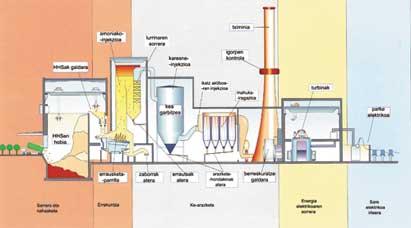
Fidel Vicandi. Zabalgarbi press officer.
Buletina
Bidali zure helbide elektronikoa eta jaso asteroko buletina zure sarrera-ontzian











